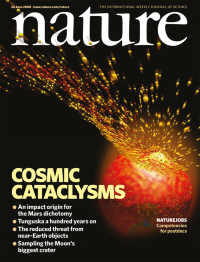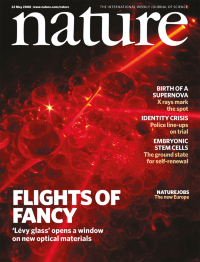Volume 453
-
No. 7199 26 June 2008
There is a north-south divide on Mars. The southern highlands covering about 60% of the planet, are heavily cratered, while the northern lowlands are lightly cratered and geologically younger, with a thinner underlying crust. Favoured explanations for this 'hemispheric dichotomy' are mantle convection or a giant impact, but there is little evidence to distinguish between the theories. Three Letters in this issue provide support for the giant impact model. Marinova et al. present dynamical simulations of dichotomy-forming impacts that demonstrate the feasibility of a giant impact origin. A simulation with favoured impact conditions is shown on the cover: the snapshot is about 30 min after impact and the colours code for internal energy. (Cover image: S Lombeyda, Caltech Center for Advanced Computing Research/ M Marinova & O Aharonson, Caltech.) Andrews-Hanna et al. use gravity and topography data to map the dichotomy boundary beneath the Tharsis volcanic province, and find an elliptical boundary, consistent with an oblique giant impact origin. Nimmo et al. use numerical modelling to show that a vertical impact, as well as excavating a crustal cavity of the right size, can explain the observed crustal disruption and the formation of the northern lowlands crust. In an accompanying News & Views , Walter Kiefer sums up the evidence for the impact model.
-
No. 7198 19 June 2008
This issue sees the publication of the draft genome sequence of an animal that has been studied by biologists for many years as a model for a primitive chordate. The amphioxus or lancelet is a small worm-like creature usually to be found buried in sand on the sea floor. Comparative analysis of the genome of the Florida lancelet, Branchiostoma floridae, reveals 17 ancestral chordate linkage groups conserved in the modern amphioxus and vertebrate genomes despite more than half a billion years of independent evolution. From this it possible to make a virtual reconstruction of the 17 chromosomes of the last common vertebrate ancestor. This reconstruction shows that as suspected, two rounds of whole genome duplication have occurred during evolution of the jawed vertebrate lineage. And it illuminates the murky relationships between the three chordate groups, the tunicates, lancelets and vertebrates.
Insight
-
No. 7197 12 June 2008
A low tissue pH is often associated with disease - for example cancer, ischaemia and inflammation - so a technique that could image tissue pH would have considerable potential for disease diagnosis and for monitoring response to treatment. A new, non-invasive method of pH imaging has now been devised, and demonstrated by monitoring the extracellular pH in living mice. It combines magnetic resonance imaging (MRI) and the intravenous injection of carbon-13-labelled bicarbonate - made extremely sensitive to detection by the use of dynamic nuclear polarization. Bicarbonate is a natural buffer in mammalian tissues, resisting pH change via interconversion with carbon dioxide in the reaction catalysed by carbonic anhydrase. The ratio of labelled bicarbonate to carbon dioxide can be used to calculate pH from the Henderson-Hasselbalch equation. Images of mice with implanted tumours confirmed a reduced tumour pH, and suggest that clinical application of the new technique is a realistic proposition. On the cover, colur in the images represents pH. Cover graphic: Mikko Kettunen & Rebekah McLaughlin.
-
No. 7196 5 June 2008
The mapping of large-scale human movements is important for urban planning, traffic forecasting and epidemic prevention. Work in animals suggested that their movements might be explained in terms of a random walk, a mathematical rendition of a series of random steps, or a Lã©vy flight, a random walk punctuated by an occasional larger step. The role of Lã©vy statistics in animal behaviour is controversial, but the idea of extending it to human behaviour was boosted in 2006 by a report of Lã©vy flight-like patterns in human movement tracked via dollar bills. A new human study, based on tracking the trajectory of 100,000 cell-phone users for six months, reveals behaviour close to a Lã©vy pattern, but deviating from it as individual trajectories show a high degree of temporal and spatial regularity: work and other commitments mean we are not as free to roam as a foraging animal. But by correcting the data to accommodate individual variation, simple and predictable patterns in human travel begin to emerge.
-
No. 7195 29 May 2008
Microbiologists are beginning to understand how and why mammals are colonized by multitudes of symbiotic bacteria. But what differentiates 'good' from benign or harmful bacteria remains largely unknown. The intestinal microbe Bacteroides fragilis was shown in 2005 to have profound effect on the mammalian immune system, an effect ascribed to a single molecule, capsular polysaccharide A (PSA). Now B. fragilis PSA is shown to protect animals against both bacterial and chemical colitis in a process involving interleukin-10 producing T cells. This suggests that B. fragilis helps maintain human health by suppressing the intestinal inflammatory response, and that symbiosis factors may provide a route to new therapies. The cover graphic (by Tom DiCesere, Sarkis Mazmanian & Dennis Kasper) represents the actin niof microbe and its symbiosis factor in the human intestine. Work in this field is being promoted by several major efforts to characterize the human microbiota and determine its role in health and disease, including the Human Microbiome Project. In News Features, Asher Mullard examines the various approaches, and Apoorva Mandavilli reports on a rare opportunity to watch the gut being colonized from scratch after intestinal transplants.
-
No. 7194 22 May 2008
Translucent materials such as milk, clouds and biological tissues owe their appearance to the way they interact with light, randomly scattering an incident ray many times before it re-emerges. This process ãâ analogous to the brownian motion of particles in a fluid ãâ is called a random walk, a concept central to statistical physics. It is used, for example, to describe the diffusion of heat, light and sound. An extension of this idea is the Lãâ©vy flight, where a moving entity can occasionally take unusually large steps, thereby transforming a systemãâs behaviour. Lãâ©vy flights have been recognized in systems as diverse as earthquakes and animal food searches. Barthelemy et al. have now engineered such behaviour into an optical material (titanium dioxide particles in a glass matrix). In the resulting ãâLãâ©vy glassãâ, rather than regular diffusion, light waves perform a Lãâ©vy flight, in which photons spread around extremely efficiently. This will be an ideal model for studying Lãâ©vy flights, and may also lead to novel optical materials. The cover the photonsãâ path, with the light source top right. Photo by Diederik and Leonardo Wiersma
-
No. 7193 15 May 2008
The air bubbles trapped in the Antarctic Vostok and EPICA Dome C ice cores provide composite records of levels of atmospheric carbon dioxide and methane covering the past 650,000 years. Now the record of atmospheric carbon dioxide and methane concentrations has been extended by two more complete glacial cycles to 800,000 years ago. The new data are from the lowest 200 metres of the Dome C core. This ice core went down to just a few metres above bedrock at a depth of 3,270 metres. Two papers report analyses of this deep ice, including the lowest carbon dioxide concentration so far measured in an ice core. Atmospheric carbon dioxide is strongly correlated with Antarctic temperature throughout the eight glacial cycles, but with significantly lower concentrations between 650,000 and 750,000 years before present. The cover shows a strip of ice core from another ice core in Antarctica (Berkner Island) from a depth of 120 metres. Photo credit: Chris Gilbert, British Antarctic Survey.
Insight
-
No. 7192 8 May 2008
The duck-billed platypus (Ornithorhynchus anatinus) is a unique egg-laying mammal, with lactation, venom and a bill. It even has an electro-sensory system for foraging underwater. Platypuses are monotremes descended from the most basal branch of the mammalian lineage and combine aspects of both reptilian and mammalian biology. Now an international consortium reports the sequence and analysis of the platypus genome. It is an amalgam of reptilian, mammalian and its own unique characteristics that provides clues to the function and evolution of all mammalian genomes. This has helped uncover the origins of genomic imprinting; platypus venom proteins were co-opted independently from the same gene families that provided reptile venom; milk protein genes are conserved; and immune gene family expansions are directly related to platypus biology. As well as providing an invaluable resource for comparative genomics, the sequence will be important for monotreme conservation. The cover image (by D. Parer & E. Parer-Cook) shows the unique bill with electro-sensory pits, eye and ear opening behind the eye.
-
No. 7191 1 May 2008
RNA localization is important in many biological processes that involve the establishment or maintenance of polarity. Previously there has been no comprehensive identification of RNAs that localize during the polarization of mammalian cells, but that has now been achieved in a study of fibroblasts responding to migratory stimuli. A genome-wide screen identified more than 50 RNAs that localize to cell protrusions extending from mouse fibroblasts. The RNAs are anchored in granules concentrated at the plus ends of microtubules, a novel RNA anchoring mechanism and an unanticipated function for microtubule plus ends. RNAs in these granules are associated with the tumour suppressor protein adenomatous polyposis coli (APC), a multi-function protein extensively studied as a component in the Wnt signalling pathway, also thought to be involved in cell migration, cell adhesion and mitosis. The cover image shows RNA granules (blue) at the tip of a cell protrusion, which has also been stained for actin filaments.









